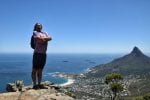Last Updated on 28 August 2024 by Cycloscope
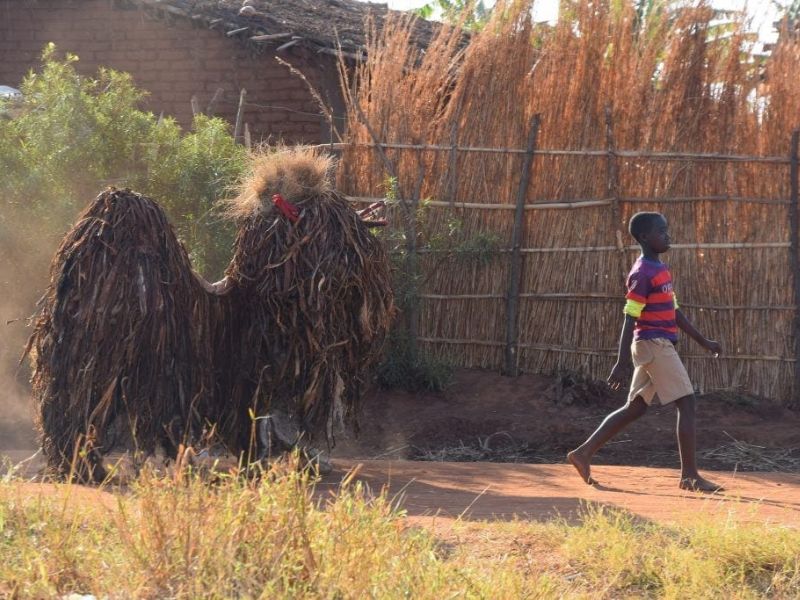
Culture, traditions, initiation ceremonies, dance, and costumes in Malawi – Gule Wamkulu, and Nyau secret society
The sacred dance of the Chewa People and our meeting with one of the oldest religions in Africa
We knew that among the Southern African nations, Malawi is probably the densest with traditions, cultural peculiarities, full of masks, dances, music… We heard about the complicated initiation ceremonies in Malawi, but nothing we knew about its secret society, the Nyau.
During our bicycle trip through Africa, we left Cape Town (South Africa) and rode through Lesotho, Eswatini, Mozambique, Zimbabwe, and Zambia, ending up in Malawi.
Before arriving here, we tried to find out more about the culture of Malawi, and how to see a traditional ceremony or dance in its real contest (not as a show for tourists). That’s how we discovered about the Gule Wamkulu… but where and how to see it, was a totally different matter.
The internet didn’t have an answer, so we joined Malawin groups on social networks and asked locals and expats living in Malawi. Still no real answer. And just when we had lost our hopes, the incredible happened: we literally bumped into a Gule Wamkulu!
From the capital Lilongwe, we headed to Cape Maclear, one of the most famous locations on the beautiful and enormous Lake Malawi.
Instead of riding on the main road, paved but rather boring, we confided in our GPS navigator that led us through small country roads, and single tracks, unreachable by car, through numerous small villages and cultivated fields.
A beautiful road that also gave us a fantastic surprise, we came across a ceremony for the arrival of the new chief of a small village, near Tete, where we witnessed the traditional sacred dance Gule Wamkulo.
This dance is part of the culture and tradition of the Cheawa People, living in Southern and Central Malawi. In this article, we will talk about this fascinating religion, its masks, and our experience of a Malawian ceremony.
If you are planning to visit Malawi, absolutely check out our Backpacking Malawi – The best travel guide about Malawi on the web
Where, when, and how to see traditional dances and ceremonies in Malawi
If you want to see for yourself while visiting Malawi, the best time to attend one of these sacred dances is during the dry season, after the harvest of July, for the whole month of August.
However, knowing for certain when and where to go to attend a Gule Wamkulu or other similar traditional ceremonies is almost impossible.
The best option is to visit the Kugoni Project at Mua Mission, here is the largest collection of Malawian ritual art in the world, here is their site (or rather “sites” since they have three). If you do not have the opportunity to pass by there, you can try to contact them for information.
Kugoni and Mua Mission also organize a large festival every year in the second half of August. Although it is not a real traditional festival, the Kugoni Festival is an excellent opportunity to attend various traditional dances.
Another possibility is to ask in one of the various Facebook groups dedicated to Malawi, Expats Malawi is in English and you should be able to get some indication.
If you are particularly interested in Gule Wamkulu and the Chewa people, obviously you will have to find yourself in the area of Malawi inhabited by these people, take a look at this map to get an idea of the distribution of the various ethnic groups in Malawi.
We recommend watching the movie “The Boy Who Harnessed the Wind“, you can find it on Netflix, where you can guess the role of Gule Wamkulo and how it was also used, and still is, for political purposes.
It seems that President Banda, who remained in power for 30 years, used masks to scare people and convince them not to protest.
When you really want something the universe conspires for you to get it. We took some narrow village roads on the way from Lilongwe to Dezda that are not on Google, amazing themselves. We were trying to reach Dezda but it was too late, so we asked around if there was a rest house in Lobi and a random guy pointed us to Tete so we changed our route. (read more…)
Culture in Malawi: Origins, life, and society of the Chewa people

The Chewa people are one of the many ethnic groups descending from the so-called Bantu Civilization, that began to migrate from central and southern Africa thousands of years ago, reaching Malawi around 1500 BC.
The Chewa (language Chichewa) is one of the predominant groups in Malawi, with a population of 1.5 million people – among the many diverse cultures of Malawi, the Chewa traditions are pretty unique.
Theirs is a matrilineal society, the land is inherited by the maternal line and also the profits from the sale of the harvest belong to the woman.
Since a man can have many wives (we met some who have ten or more), the children of the same mother (lubele la achite) form a family of dependents or Mbumba.
The elder brothers of the mothers are called Nkhoswe, they are the guardians of the lineage and mentor the children of their sisters.
The village is led by a chief (Mfumu), a position to which every resident of good character can aspire. The leaders and women of the village were subordinate to the regional leaders (Mwini Dziko), who were themselves subordinated to the paramount chiefs.
Subordination means the regular payment of tax, as well as the willingness to provide for men in times of war. At least this is the traditional cultural model of the Chewa people, how the Chichewa traditions are adapting to modern Malawian culture, and society is a poorly studied and debatable matter.
Despite being a matrilineal society, what we have seen in everyday life is that women work all day, often doing very strenuous tasks like collecting firewood or water, they always carry heavy baskets on their heads and at least one child on the back, cook meals for the whole family and take care of the many children.
Drinking beer, dancing at bars, and playing billiards seem to be man-only activities, moreover, women speak much less English than men, which means they have had, on average, less access to school. The literacy rate among young people, between 15 and 24 years, is in fact 71% for females and 82% for males.
Near the Tete junction we saw a monster, and then a faceless spirit, then a crowded circle of people… We approached, a bit intimidated… They let us in, with all the bikes, everyone staring at us, even the spirits. It is a Gule Wamkulu, spirits fight each other and compete in symbolic dances… (read more…)
The Secret Society of the Chewa People: Nyau
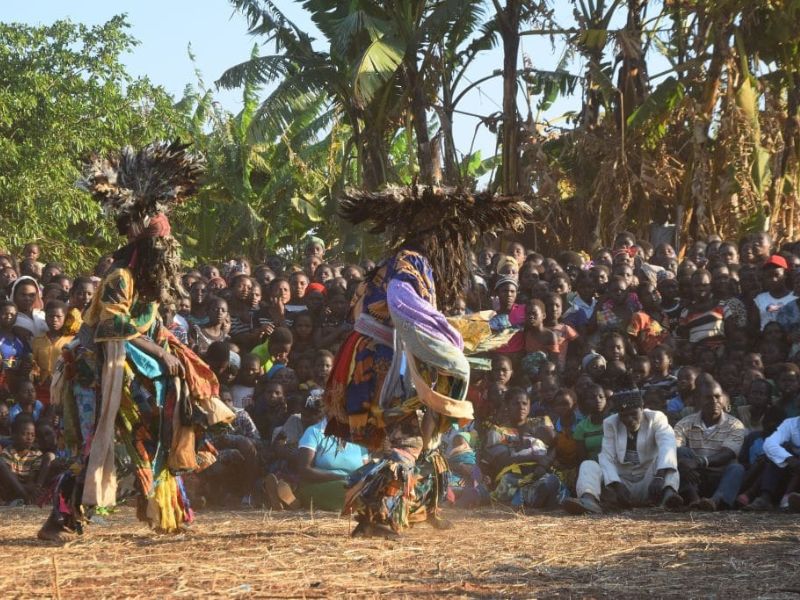
The religion of the Chewa people, Nyau, apparently originated in today’s Democratic Republic of the Congo, where a rock painting depicting Kasiya Maliro and dating back to 992 AD has been found.
Kasiya Maliro is the costume representing the mother. In Malawi, it is called Kasiyamaliro and is the Great Mother of Gule Wamkulu and probably the most important Nyau figure.
It is said to be the principle of the Nyau, the symbol of the mother of everything. Serving as a comforter of souls in transition, she is almost omnipresent at every ritual performance or traditional dance of the Chewa culture in Malawi.
The Kasiyamaliro is an ancestral spirit, an antelope of pure and ancient origins. It seems to have been born from the white and serene waters of the earthly depths, from which all the Chewa spirits come, the depths of the world. Under its belly lies the abyss of the world, the womb of the Great Ancestral Mother, and the tomb.
The Chewa people, therefore, believe in the existence of the Nyau (or Nyao), a secret society whose name means mask or initiation.
The Nyau society is composed of initiated members of the Chewa and Nyanja people, the initiation ceremonies are separated for men and women, with different knowledge learned and with different ritual roles in society based on gender and seniority. Only initiates are considered mature and members of the Nyau.
There is a Nyau society in each village, but they are part of a vast network of Nyau extending through the central area and part of the southern regions of Malawi, eastern Zambia, western Mozambique, and areas of Zimbabwe, where the people Chewa emigrated from Malawi.
The Nyau religion survived the colonial period, when missionaries forbade the population of Malawi from any traditional practice, dances, music, initiation rites, etc.
The Chewa adapted themselves to some aspects of Christianity which, still today, is still the most practiced religion in Malawi, with Chewa members belonging both to a Christian church and to the Nyau society.
To protect themselves from the British colonial authorities, the members of the Nyau began to establish punishments for anyone who revealed the mysteries of the secret society to uninitiated people or, worse still, those who were not part of the religion.
Revealing the real names of the people wearing the masks could also be punished with death. This is one of the main reasons why not much is known about the origins of the Nyau.
Although some other ethnic groups have developed various and elaborate traditional dances in Malawi, including the Ngoni, the Yao, and the Mang’anja, the Cheya Nyau can be considered the most elaborate of secret societies and dances in the areas around Lake Malawi.
The Gule Wamkulu is the upside down. Every element of reality has its double, literally every one… The mother, the dog, the helicopter, the British colonialist with a red nose and burned face… (read more…)
The belief system of the Chewa people of Malawi
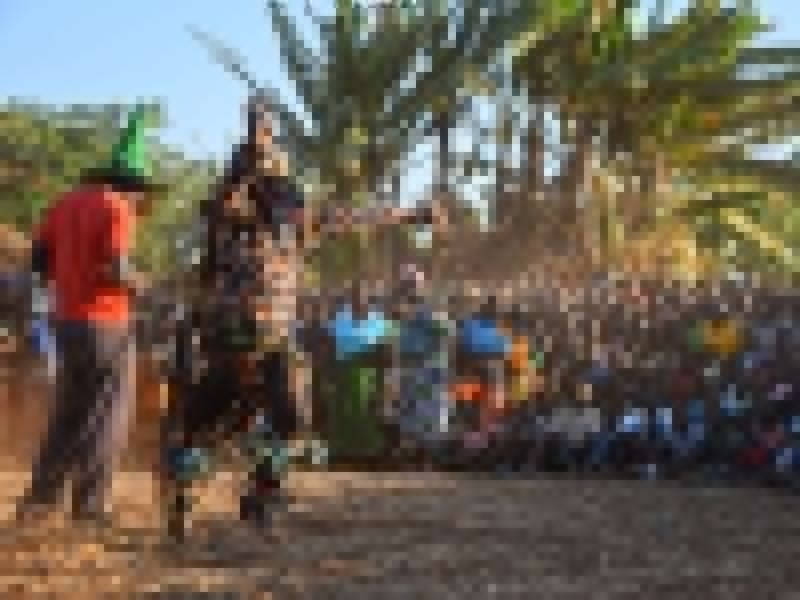
The Chewa believe that life exists within their ancestors and those not yet born, just like it exists in the living. Nyau’s beliefs include communicating with those who died, or with their spirits, calling this pampero lalikulu (great prayer) act.
They believe in the presence of God in everyday life, a God that is both male (in the sky) and female (in the earth) at the same time. One of the most important ritual moments in the Chewa culture of Malawi is the traditional Gule Wamkulu dance and ceremony.
???? The Gule Wamkulu explains the world by way of its ghosts, gives complex answers to the mysteries of life and death… It’s a serious matter, to be vehicle for the spirits you’ll have to undergo an initiation into the secret society, so secret that one can be killed just for talking about it. That’s why anthropologists still know very little about it. (read more…)
The great dance: Gule Wamkulo
The symbolism of the spirit world is represented by the Gule Wamkulu (great dance), which incorporates mwambo (traditions), masks, songs, and dance.
The Nyau tradition of Malawi incorporates sophisticated reverse-role-playing games, proverbs, imitation, and satire in performances. Primarily the Nyau perform their masquerade dances at funerals, commemorations, and initiations.
Each dancer represents a special character related to the mask or animal costume (or anthropomorphized animal) he wears. The zilombo (wild animals) are large structures that cover the entire body and represent mostly animals, while the masks worn on the face are mainly ancestral spirits.
Before the Gule Wamkulu dance, the Nyau dancers observe a series of rituals associated with their secret brotherhood. The secrecy behind the Nyau incorporates a coded language, riddles, metaphors, myths, and signs.
During masked performances, women and children often run into homes when a Nyau mask threatens them, as masks are worn only by male-initiated members of society and represent male knowledge.
At the time of the exhibition and in the rituals, the masked dancers Nyau are considered spirits of the dead. As spirits, they can act with impunity and there have been attacks and deaths during traditional ceremonies in Malawi in the past.
The dances of the Nyau involve intricate footwork, jumps, acrobatics, mimed fights, and the casting of dust in the air. Dancers respond to certain rhythms and drum calls based on the type of mask or character.
Although it may be considered a popular dance by many, this is certainly not the case; The Gule Wamkulu should rather be considered a religious dance since its function is to communicate with the ancestral world.
In 2005, Gule Wamkulu was ranked as one of the 90 masterpieces of the oral and intangible heritage of humanity, a UNESCO program for the conservation of intangible cultural heritage.
The traditional Malawian Gule Wamkulu dance is also known as pemphero lathu lalikulu la mizimu (“a great prayer for our ancestors”) or gulu la anamwaliri (“ancestor dance”).
In the dance/ceremony we saw, the masks and costumes are inside a circle made up of the people of the village, the position of the people in the circle reflects the role in the society.
Some masks took sand from the ground and cast it to the spectators, in the front row there were the children, who ran away and then returned to their initial position.
⛪ When the first colonists arrived in Malawi, they of course tried to ban this “devilish thing”… But, as it very often happens with the catholics, they ended up mixing elements of the Christian mythology into the shamanist practice: the great mother became Maria, the white colonists Saint Peter, and so on. (read more…)
Malawi Initiation Ceremony and the World of the Traditional Spirits

The initiation of men into the secret society takes place in a burial place in the woods, where the initiate must reside for a week (this period was much longer in the past).
Novices are beaten and whipped with branches while learning the discipline – a practice that continues even once they become part of the cult.
The initiation rite is complex and differs between groups, in some cases, the initiate is required to suck blood from live chickens, handle harmless snakes (sometimes used during rituals), and other amenities.
In some villages, the newly initiated are blindfolded for three days, followed by a two-week word ban. Initiation often involves circumcision.
Not much else is known about the Nyau initiation ceremonies in Malawi, the initiation practices are indeed among the best-defended secrets in this traditional cult.
During the ritual, the men of the Nyau are true spirits, and they cannot be considered human beings, even if the women recognize their husbands, fathers, brothers, and uncles.
In Malawi, identifying the man wearing a mask is a serious violation of the secret of traditional Nyau religion, and can be severely punished.
Uninitiated men, women, and children can be chased by Nyau artists, and non-members are discouraged from approaching during funerals.
In part, this serves to prevent outsiders from being disrespectful, not understanding the importance of a “good” burial and the meaning of the presence of the dead.
So that the most important moments of the community’s life, weddings, funerals, new chiefs, and such, assume a triple significant, existing in three different worlds: the material plan, the Christian faith and the world of the traditional spirits. (read more…)
Like Traditional Festivals?
Cap Go Meh – Having your Soul pierced by the Spirits in Indonesian Borneo
The Pasola of Sumba Island – The Blood Must Be Shed
The Malawian Masks of Gule Wamkulu
The variety of masks representing spirits and ancestors is enormous and constantly growing, unlike the animal structures that instead remain similar to themselves.
The masks are therefore not only traditional but in constant evolution, to respond to changes in real society. There is a mask for everything, the whole universe is represented in the upside-down world of the Nyau.
Some mask carvers are professionals, while others are occasional artisans. The costumes are generally made with banana leaves and other materials, for example, we have seen t-shirts of famous soccer teams.
Over 400 masks associated with the Nyau society and the Gule Wamkulu ritual are exhibited at the Chamare Museum in the district of Dedza (MUA Mission), Malawi.
Nyau masks are made of wood and straw and are divided into three types:
- The first belongs to the masks made of natural materials (feathers, straw, and others) – the least important
- At the second are the wooden masks – important but common
- The third is a large zoomorphic structure that envelops the entire body of the dancer – the rarest and most powerful
Wearing the latter type of costume, dancers tend to turn around and turn around in a movement known as nyau yolemba. These are representations of a wide variety of characters, including wild animals such as antelopes, lions, and hyenas.
With names like Bwindi, Chibano, and Wakana, the masks portray a variety of traits and types such as a womanizer, a helpless epileptic, allegorical characters such as lust, greed, madness, vanity, infertility, witchcraft, and ambition, and even a helicopter.
The masks and exhibitions represent all of humanity and the whole world of spirits. Among the many types of masks, traditional and not, we list some of them:
- Bwana wokwera pa ndege/pa galimoto (Mister in a plane/in a car) This mask shows how those who have already had money and power in their lives, will also keep them once they have passed into the ancestral world.
- Chabwera Kumanda (the one who came back from the grave) is a character that misunderstands people, an ancestor who hunts people in their own dreams to get attention and offers (eg beer, meat, etc.). During his dance, Chabwera kumanda is in fact in pursuit of the spectators, thus emphasizing the wickedness of the character.
- Kasinja or Kamchacha is the messenger of important ancestors. Sometimes it acts in part as a sort of anchorman telling which masks or animal approaches to perform in its dance.
- Kondola which originated as Msakambewa (“Hunter of mice”), then turned into Ndola (a man in a copper mining town), subsequently changing once again into Chizonono (someone suffering from gonorrhea), is an example of a mask that has undergone a transformation due to change, political pressures, and social influences.
- Maliya (from Maria) represents an ancestor with a kind heart. This dancer will sing and dance with the people. One of several examples of the cultural mix between Christianity and Nyau.
- Mfiti (sorcerer) wears a very ugly mask and in general, has a demolished and bristly appearance. The external form recalls its evil character since it is believed that sorcerers kill people with their juju (magic power).
- Simoni (from Saint Peter) wears a red mask, similar to a “white man” with sunburns, and a suit made of rags. This character seems to be clearly the caricature of an English colonialist.
- Makanja (mask on stilts) is a warrior and acrobat with great power, epitomizing a Makanja requires a high level of juju, Makaja stilt walkers are in fact among the most powerful masks in the Nyau hierarchy.
Like African ancestral cultures? Read also
> Lake Eyasi Guide [Tanzania] Hadzabe Bushmen, Walking Safaris
Animal-Structures Costumes in the Gule Wamkulu
The members of Nyau who wear animal structures represent wild animals or nyama za ku tchire, they appear at the time of the death of people and are therefore feared and revered.
There is a sort of hierarchy between the different animals, with some highly respected animals (such as njobvu, the elephant) and some less important ones.
It is also believed that highly respected animals also represent very important ancestors as leaders or members of the Nyau cult.
Most animal structures usually have a barrel shape, with a bottom entry hole. Inside the structure, the bars are mounted to transport the structure around.
All the structures completely cover the dancer, whose footprints are swept away with brooms of branches by members of the Nyau. Here are some structures, explained in order of importance:
- Njobvu (the elephant) is the most important figure of them all. Four Nyau dancers are needed to move this structure. Njobvu remembers an important leader, since the elephant is the most important animal for the Chewa people, due to its size and its dangerousness. This rare structure is seen only at funerals for the chiefs.
- Ndondo (the snake) is the second most important structure and is carried by up to twelve men. It also represents an important ancestor and is often seen at funerals for Nyau members.
- Mkango (the lion) recalls the evil spirit of an ancestor, which attacks and kills people. Therefore, some people run away as soon as they see Mkango approaching. The figure of Mkango explains that the ancestors should not be bothered, just like a lion should not be bothered, as it could attack people for their disrespect.
- The forms of antelope are considered the most beautiful and are the most frequent in the Gule Wamkulo. Often covered with intertwined maize shells, these forms of masks are the first to appear in performances to commemorate the deceased and to represent the union between the dead and the spirits/ancestors. Their performance marks a moment of remembrance and celebration of life. The most important is the already mentioned Kasiyamaliro (leaving the funeral/burial).
Dance and Culture for a socio-political Change in Malawi
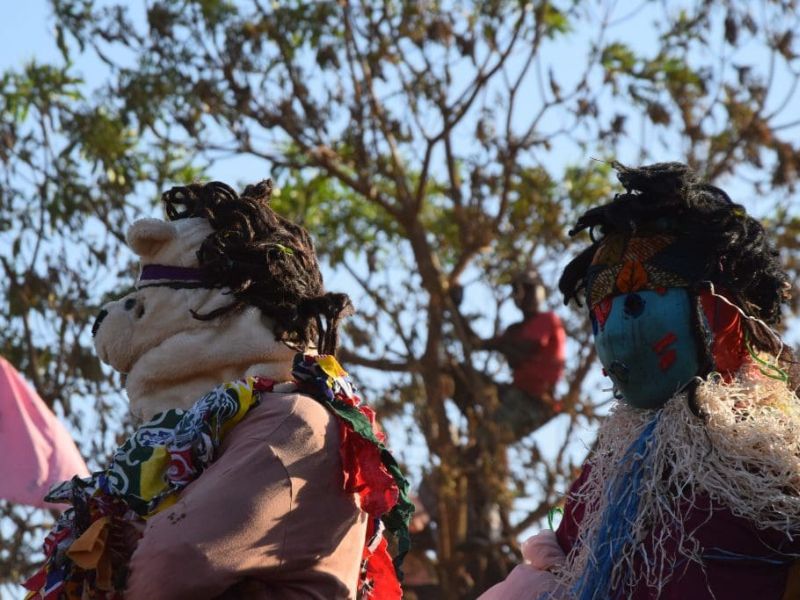
The traditional Gule Wamkulu rite is not just about unusual costumes and terrifying masks. The dance is used to convey a message.
The Gule Wamkulu unites the worlds: the human, the animal, and the spiritual world, presenting figurative discourses that however often deal with practical questions concerning the life of the village and the community, often questions that are difficult to talk about, such as HIV / AIDS or sex. These topics are addressed through dance.
The dancers of the Nyau also have the power to criticize the leaders and the government. They use humor and satire to make political statements. They have the strength to do so because, while they dance, they are seen as spirits, not humans.
Even political leaders have harnessed the power of this traditional cult. The founding president of Malawi, Hasting Kamuzu Banda – who was himself Chewa – used Nyau’s performances to intimidate people who were perhaps critical of his regime or simply to “keep the population inline”.
We felt like being in the way of the ceremony, to some people we were welcomed guests but to some other we are intruders. We stayed about 30 minutes, we would have liked to stay forever but didn’t want to ruin the ceremony with our presence and our bulky bikes. We have experienced what we really wanted to feel… It was intense and astonishing, these feelings will never leave us… Hopefully we’ll back into the circle one day (read more…)



